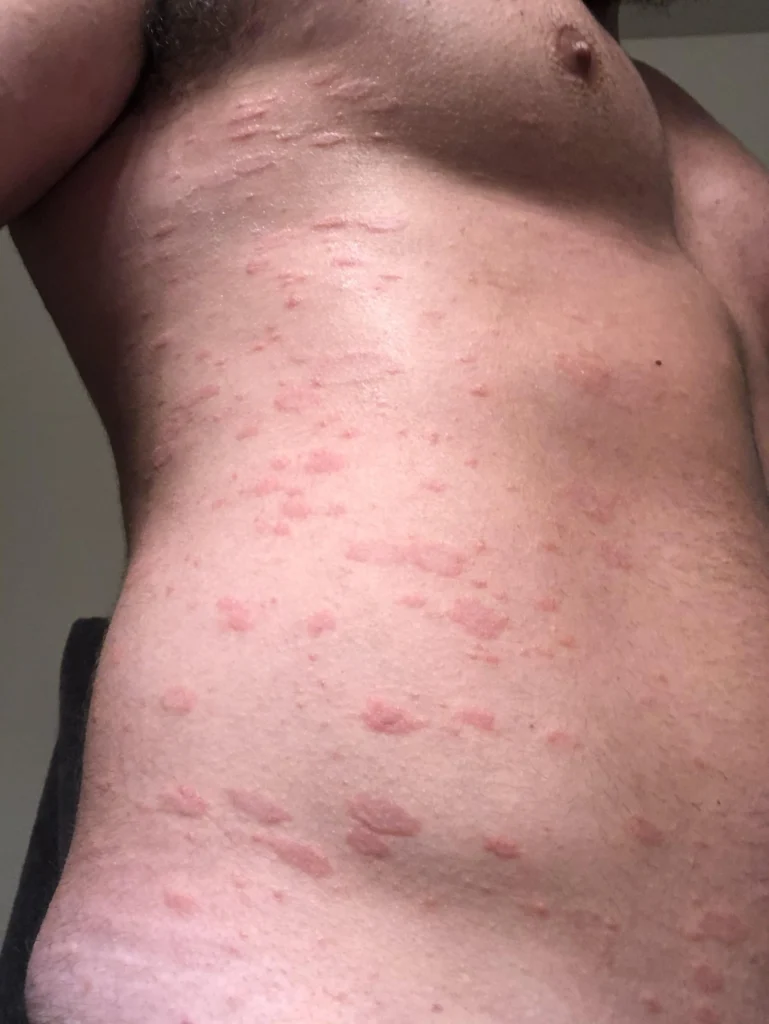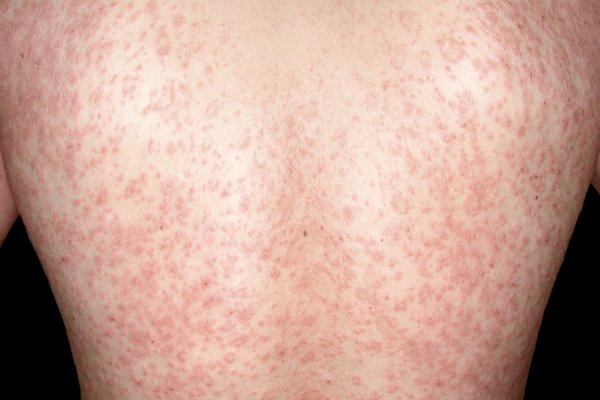Pityriasis rosea typically starts as a large oval patch on the face, chest, abdomen, or back, known as a herald patch, which can be as large as 4 inches (10 centimeters) across. Following this, smaller spots resembling drooping pine-tree branches may appear, spreading out from the center of the body. The rash can sometimes cause itching.
This condition, pronounced pit-ih-RIE-uh-sis roh-ZEE-uh, can occur at any age but is most common between 10 and 35 years old. It usually resolves on its own within about 10 weeks.
Pityriasis rosea is a common skin condition that results in discolored patches on the skin. While a viral cause is suspected, it remains uncertain. Most cases resolve without treatment, though some treatments can help alleviate symptoms such as itching.
Treatment options may include medicated lotions to reduce itchiness and speed up the rash’s disappearance. However, in many cases, no treatment is necessary. The condition is not contagious and rarely recurs.
Who does pityriasis rosea affect?
Pityriasis rosea can affect anyone, but certain factors may increase your likelihood of developing it:
- Age: It’s most commonly seen in individuals between 10 and 35 years old.
- Gender: Women are 50% more likely to develop pityriasis rosea compared to men.
- Stress: Some people report experiencing significant stress before developing the rash, though more research is needed to understand the relationship.
Pityriasis rosea typically affects the skin on the trunk, arms, or legs. In rare cases, a variant known as inverse pityriasis rosea may involve the skin on the neck, face, armpits (axillae), and groin. The rash appears as discolored patches resembling scales or dry, crinkly paper, which may be accompanied by itching.
Symptoms of Pityriasis Rosea:
Pityriasis rosea typically progresses through several stages: Initially, you might experience symptoms like fever, headache, or an upper respiratory infection.
A large, raised, circular or oval patch appears, known as the “herald” or “mother” patch, ranging from 1 to 6 centimeters in size.
After about one to two weeks, smaller patches develop in groups near the herald patch. These are called “daughter” patches, usually about 1 to 2 cm in size, forming a pattern resembling drooping Christmas tree branches.
Itching accompanies the rash in about 50% of people affected by pityriasis rosea.
In individuals with darker skin tones, the patches may appear more raised (papular), with centers that may resemble necrotic tissue.
Pityriasis rosea itself is not painful, but scratching the patches can lead to skin breaks and potential infections.

Causes of Pityriasis Rosea:
Pityriasis rosea is believed to be caused by herpesviruses like HHV-6, HHV-7, and possibly HHV-8, though conclusive studies are lacking. These viruses are distinct from those that cause cold sores or genital herpes.
Relation to COVID-19:
While some studies suggest a potential association between COVID-19 and skin conditions like pityriasis rosea, conclusive evidence linking COVID-19 as a direct cause of pityriasis rosea is still lacking.
Difference Between Pityriasis Rosea and Ringworm:
Pityriasis rosea and ringworm share similarities in their appearance as papulosquamous disorders, characterized by raised, discolored, scaly patches on the skin. However, ringworm is caused by a fungal infection, whereas the exact cause of pityriasis rosea remains unknown, though it’s thought to involve viral factors.
SIMILARITIES AND DIFFERENCES BETWEEN Pityriasis rosea AND PITYRIASIS VERSICOLOR
Pityriasis rosea and tinea versicolor are both skin conditions that can cause discolored patches on the skin, but they differ in several key aspects:
Similarities:
- Skin Appearance: Both conditions can present with patches or lesions on the skin.
- Itching: They may cause itching, although the severity can vary.
- Not Contagious: Neither condition is contagious.
Differences:
Cause:
- Pityriasis Rosea: The exact cause is uncertain, but it’s thought to be linked to viral infections, particularly human herpesvirus 6 (HHV-6) and HHV-7.
- Tinea Versicolor: Caused by the yeast Malassezia furfur, which is a type of fungus that naturally lives on the skin.
Age Affected:
- Pityriasis Rosea: Commonly affects individuals between 10 and 35 years old, with a higher incidence in women.
- Tinea Versicolor: Occurs more frequently in adolescents and young adults, especially in tropical and subtropical regions.
Distribution of Rash:
- Pityriasis Rosea: Typically starts with a single large patch (herald patch) followed by smaller lesions that spread outward in a pattern resembling pine-tree branches. It commonly affects the trunk and extremities.
- Tinea Versicolor: Often appears as small, round, or oval patches that can be lighter or darker than the surrounding skin. It commonly affects areas such as the chest, back, neck, and upper arms.
Treatment:
- Pityriasis Rosea: Usually resolves on its own within weeks to months without specific treatment. Symptomatic relief may be achieved with moisturizers or mild topical steroids for itching.
- Tinea Versicolor: Typically treated with antifungal medications, either topical creams, lotions, or shampoos for mild cases, or oral antifungal medications for more severe or widespread infections.
In summary, while both pityriasis rosea and tinea versicolor can cause skin discoloration and some itching, they differ in their underlying causes, age groups affected, distribution of the rash, and approach to treatment.

Diagnosis of Pityriasis Rosea:
Pityriasis rosea is typically diagnosed based on a physical examination by your healthcare provider. However, because it can resemble other skin conditions like eczema, psoriasis, ringworm, or tinea versicolor, additional tests may be conducted if there is uncertainty. These tests may include:
- Allergy test.
- Biopsy.
- Blood tests to rule out other causes of rash unrelated to pityriasis rosea.
Management and Treatment:
Pityriasis rosea often resolves on its own within six to eight weeks without requiring treatment.
If the rash is very itchy and causing discomfort, your healthcare provider may recommend the following treatments to alleviate symptoms:
- Antivirals: Medications that help combat viral infections.
- Phototherapy: Treatment using ultraviolet B (UVB) light from specialized lamps. It’s effective for certain skin disorders, including pityriasis rosea. However, UVB exposure can lead to hyperpigmentation in darker skin tones even after the rash clears, so it’s important to discuss this option thoroughly with your healthcare provider.
- Prednisone tablets: Oral corticosteroids like prednisone may be prescribed to reduce inflammation in the skin and other affected areas.
Home Remedies for Pityriasis Rosea Symptoms:
There are several over-the-counter and home remedies that can help alleviate itching and discomfort associated with pityriasis rosea. It’s advisable to consult your healthcare provider before trying these remedies, especially if you have concerns about allergic reactions:
- Antihistamines: These medications are commonly used to relieve allergy symptoms, including skin itching.
- Calamine lotion: Helps soothe itching and discomfort while also moisturizing dry, scaly skin.
- Hydrocortisone creams or ointments: Topical corticosteroids combined with anesthetic agents can provide relief from itching and inflammation.
- Oatmeal: Colloidal oatmeal, ground into a fine powder and mixed with warm water to form a paste, can soothe itchiness when applied to the rash. After letting it sit for at least 10 minutes, gently wipe off with a clean towel.
These treatments and remedies can help manage symptoms of pityriasis rosea, promoting comfort during the healing process. Always follow your healthcare provider’s recommendations for the best approach to treating your specific case.
